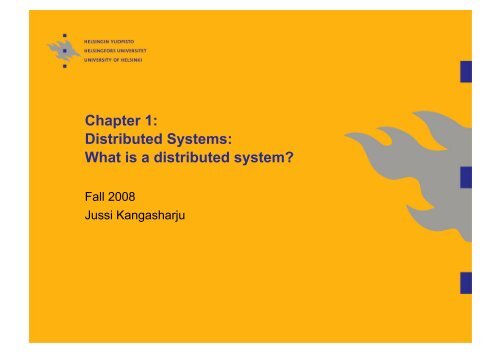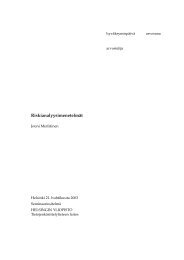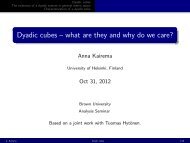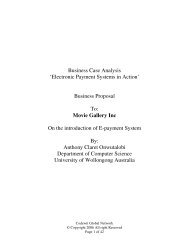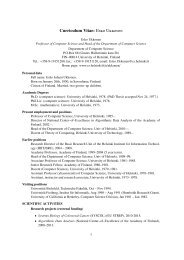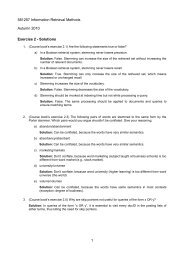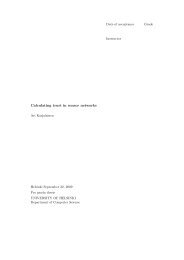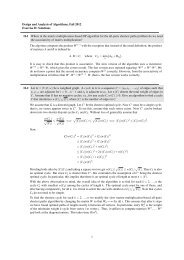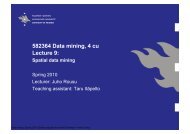Chapter 1: Distributed Systems: What is a distributed system?
Chapter 1: Distributed Systems: What is a distributed system?
Chapter 1: Distributed Systems: What is a distributed system?
You also want an ePaper? Increase the reach of your titles
YUMPU automatically turns print PDFs into web optimized ePapers that Google loves.
<strong>Chapter</strong> 1:<br />
<strong>D<strong>is</strong>tributed</strong> <strong>Systems</strong>:<br />
<strong>What</strong> <strong>is</strong> a d<strong>is</strong>tributed <strong>system</strong>?<br />
Fall 2008<br />
Jussi Kangasharju
Course Goals and Content<br />
� <strong>D<strong>is</strong>tributed</strong> <strong>system</strong>s and their:<br />
� Basic concepts<br />
� Main <strong>is</strong>sues, problems, and solutions<br />
� Structured and functionality<br />
� Content:<br />
Kangasharju: <strong>D<strong>is</strong>tributed</strong> <strong>Systems</strong><br />
� <strong>D<strong>is</strong>tributed</strong> <strong>system</strong>s (Tanenbaum, Ch. 1)<br />
- Architectures, goal, challenges<br />
- Where our solutions are applicable<br />
� Synchronization: Time, coordination, dec<strong>is</strong>ion making (Ch. 5)<br />
� Replicas and cons<strong>is</strong>tency (Ch. 6)<br />
� Fault tolerance (Ch. 7)<br />
� <strong>Chapter</strong>s refer to Tanenbaum book<br />
October 23, 08<br />
2
Kangasharju: <strong>D<strong>is</strong>tributed</strong> <strong>Systems</strong><br />
Course Material<br />
� Tanenbaum, van Steen: <strong>D<strong>is</strong>tributed</strong> <strong>Systems</strong>, Principles<br />
and Paradigms; Prentice Hall 2002<br />
� Coulour<strong>is</strong>, Dollimore, Kindberg: <strong>D<strong>is</strong>tributed</strong> <strong>Systems</strong>,<br />
Concepts and Design; Add<strong>is</strong>on-Wesley 2005<br />
� Lecture slides on course website<br />
� NOT sufficient by themselves<br />
� Help to see what parts in book are most relevant<br />
October 23, 08<br />
3
Course Exams<br />
� Normal way (recommended)<br />
� Exerc<strong>is</strong>es, home exerc<strong>is</strong>es, course exam<br />
� Grading:<br />
Kangasharju: <strong>D<strong>is</strong>tributed</strong> <strong>Systems</strong><br />
� Exam 48 points<br />
� Exerc<strong>is</strong>es 12 points (~ 20 exerc<strong>is</strong>es, scaled to 0—12)<br />
� Home exerc<strong>is</strong>es 6 points (3 exerc<strong>is</strong>es)<br />
� Grading based on 60 point maximum<br />
� Need 30 points to pass with minimum 16 points in exam<br />
� 50 points will give a 5<br />
� Possible to take as separate exam<br />
October 23, 08<br />
4
Exerc<strong>is</strong>es<br />
� Weekly exerc<strong>is</strong>es:<br />
� Smaller assignments<br />
� Home exerc<strong>is</strong>es<br />
Kangasharju: <strong>D<strong>is</strong>tributed</strong> <strong>Systems</strong><br />
� 1 study diary, 2 design exerc<strong>is</strong>es<br />
� Due dates will be announced later<br />
� Study diary individual work<br />
� Design exerc<strong>is</strong>es can be done in groups of up to 3<br />
October 23, 08<br />
5
People<br />
� Jussi Kangasharju<br />
� Lectures: Mon 14-16 and Thu 10-12 in D122<br />
� Office hour: Tue 12-13 or ask for appointment by email<br />
� Mika Karlstedt<br />
Kangasharju: <strong>D<strong>is</strong>tributed</strong> <strong>Systems</strong><br />
� Exerc<strong>is</strong>e groups:<br />
- 1. Mika Karlstedt Tue 12-14 in C221 (in Engl<strong>is</strong>h)<br />
- 2. Mika Karlstedt Thu 12-14 in CK111<br />
� Home exerc<strong>is</strong>es<br />
� Office hour: During exerc<strong>is</strong>es or ask appointment by email<br />
October 23, 08<br />
6
Questions?<br />
Kangasharju: <strong>D<strong>is</strong>tributed</strong> <strong>Systems</strong><br />
October 23, 08<br />
7
Kangasharju: <strong>D<strong>is</strong>tributed</strong> <strong>Systems</strong><br />
<strong>Chapter</strong> Outline<br />
� Defining d<strong>is</strong>tributed <strong>system</strong><br />
� Examples of d<strong>is</strong>tributed <strong>system</strong>s<br />
� Why d<strong>is</strong>tribution?<br />
� Goals and challenges of d<strong>is</strong>tributed <strong>system</strong>s<br />
� Where <strong>is</strong> the borderline between a computer and a<br />
d<strong>is</strong>tributed <strong>system</strong>?<br />
� Examples of d<strong>is</strong>tributed architectures<br />
October 23, 08<br />
8
Kangasharju: <strong>D<strong>is</strong>tributed</strong> <strong>Systems</strong><br />
Definition of a <strong>D<strong>is</strong>tributed</strong> System<br />
A d<strong>is</strong>tributed <strong>system</strong> <strong>is</strong><br />
a collection of independent computers<br />
that appears to its users<br />
as a single coherent <strong>system</strong>.<br />
... or ...<br />
as a single <strong>system</strong>.<br />
October 23, 08 9
Examples of <strong>D<strong>is</strong>tributed</strong> <strong>Systems</strong><br />
The Internet: net of nets<br />
global access to “everybody”<br />
(data, service, other<br />
actor; open ended)<br />
� enormous size (open<br />
ended)<br />
� no single authority<br />
� communication types<br />
- interrogation,<br />
announcement,<br />
stream<br />
- data, audio, video<br />
Kangasharju: <strong>D<strong>is</strong>tributed</strong> <strong>Systems</strong><br />
ISP<br />
intranet<br />
desktop computer:<br />
server:<br />
network link:<br />
satellite link<br />
backbone<br />
CoDoKi, Fig. 1.1<br />
Figure 1.1 A typical portion of the Internet<br />
October 23, 08 10
Examples of <strong>D<strong>is</strong>tributed</strong> <strong>Systems</strong><br />
Intranets ( CoDoKi, Fig. 1.2)<br />
� a single authority<br />
� protected access<br />
- a firewall<br />
- total <strong>is</strong>olation<br />
� may be worldwide<br />
� typical services:<br />
- infrastructure services:<br />
file service, name<br />
service<br />
- application services<br />
Kangasharju: <strong>D<strong>is</strong>tributed</strong> <strong>Systems</strong><br />
Figure 1.2 A typical intranet<br />
CoDoKi, Fig. 1.2<br />
October 23, 08 11
Mobile and ubiquitous<br />
Examples of <strong>D<strong>is</strong>tributed</strong> <strong>Systems</strong><br />
computing ( CoDoKi Fig 1.3 )<br />
� Portable devices<br />
� laptops<br />
� handheld devices<br />
� wearable devices<br />
� devices embedded in appliances<br />
� Mobile computing<br />
� Location-aware computing<br />
� Ubiquitous computing, pervasive<br />
computing<br />
Kangasharju: <strong>D<strong>is</strong>tributed</strong> <strong>Systems</strong><br />
Figure 1.3 Portable and handheld devices in a d<strong>is</strong>tributed <strong>system</strong><br />
CoDoKi, Fig. 1.3<br />
October 23, 08 12
Mobile Ad Hoc -Networks<br />
Problems, e.g.:<br />
- reliable multicast<br />
- group management<br />
Kangasharju: <strong>D<strong>is</strong>tributed</strong> <strong>Systems</strong><br />
Mobile nodes come and go<br />
No infrastructure<br />
- wireless data communication<br />
- multihop networking<br />
- long, nondetermin<strong>is</strong>tic dc delays<br />
October 23, 08 13
Resource Sharing and the Web<br />
� Hardware resources (reduce<br />
costs)<br />
� Data resources (shared<br />
usage of information)<br />
� Service resources<br />
� search engines<br />
� computer-supported<br />
cooperative working<br />
� Service vs. server (node or<br />
process )<br />
Kangasharju: <strong>D<strong>is</strong>tributed</strong> <strong>Systems</strong><br />
www.google.com<br />
www.cdk3.net<br />
File <strong>system</strong> of<br />
www.w3c.org<br />
www.w3c.org<br />
CoDoKi, Fig. 1.4<br />
Web servers<br />
Activity.html<br />
Protocols<br />
http://www.google.com/search?q=kindberg<br />
Internet<br />
Browsers<br />
http://www.cdk3.net/<br />
http://www.w3c.org/Protocols/Activity.html<br />
Mastering openness<br />
• HTML<br />
• URL<br />
• HTTP<br />
Figure 1.4 Web servers and web browsers<br />
October 23, 08 14
Examples of <strong>D<strong>is</strong>tributed</strong> <strong>Systems</strong>, 4<br />
<strong>D<strong>is</strong>tributed</strong> application<br />
• one single “<strong>system</strong>”<br />
• one or several autonomous sub<strong>system</strong>s<br />
• a collection of processors => parallel processing<br />
=> increased performance, reliability, fault<br />
tolerance<br />
• partitioned or replicated data<br />
=> increased performance, reliability, fault tolerance<br />
Dependable <strong>system</strong>s, grid <strong>system</strong>s, enterpr<strong>is</strong>e <strong>system</strong>s<br />
Kangasharju: <strong>D<strong>is</strong>tributed</strong> <strong>Systems</strong><br />
October 23, 08 15
Why D<strong>is</strong>tribution?<br />
Sharing of information and services<br />
Possibility to add components improves<br />
availability<br />
reliability, fault tolerance<br />
performance<br />
scalability<br />
Facts of life: h<strong>is</strong>tory, geography, organization<br />
Kangasharju: <strong>D<strong>is</strong>tributed</strong> <strong>Systems</strong><br />
October 23, 08 16
Goals and challenges for<br />
d<strong>is</strong>tributed <strong>system</strong>s
Goals<br />
Kangasharju: <strong>D<strong>is</strong>tributed</strong> <strong>Systems</strong><br />
� Making resources accessible<br />
� D<strong>is</strong>tribution transparency<br />
� Openness<br />
� Scalability<br />
� Security<br />
� System design requirements<br />
October 23, 08 18
Kangasharju: <strong>D<strong>is</strong>tributed</strong> <strong>Systems</strong><br />
Challenges for Making Resources Accessible<br />
� Naming<br />
� Access control<br />
� Security<br />
� Availability<br />
� Performance<br />
� Mutual exclusion of users, fairness<br />
� Cons<strong>is</strong>tency in some cases<br />
October 23, 08<br />
19
Challenges for Transparency<br />
� The fundamental idea: a collection of<br />
� independent, autonomous actors<br />
� Transparency<br />
Kangasharju: <strong>D<strong>is</strong>tributed</strong> <strong>Systems</strong><br />
� concealment of d<strong>is</strong>tribution =><br />
� user’s viewpoint: a single unified <strong>system</strong><br />
October 23, 08<br />
20
Kangasharju: <strong>D<strong>is</strong>tributed</strong> <strong>Systems</strong><br />
Challenges for Transparencies<br />
� replications and migration cause need for ensuring<br />
cons<strong>is</strong>tency and d<strong>is</strong>tributed dec<strong>is</strong>ion-making<br />
� failure modes<br />
� concurrency<br />
� heterogeneity<br />
October 23, 08<br />
22
Figure 2.10<br />
Om<strong>is</strong>sion and arbitrary failures<br />
Class of failure Affects Description<br />
Fail-stop Process Process halts and remains halted. Other processes may<br />
detect th<strong>is</strong> state.<br />
Crash Process Process halts and remains halted. Other processes may<br />
not be able to detect th<strong>is</strong> state.<br />
Om<strong>is</strong>sion Channel A message inserted in an outgoing message buffer never<br />
arrives at the other end’s incoming message buffer.<br />
Send-om<strong>is</strong>sion Process A process completes send, but the message <strong>is</strong> not put<br />
in its outgoing message buffer.<br />
Receive- Process A message <strong>is</strong> put in a process’s incoming message<br />
om<strong>is</strong>sion<br />
Arbitrary<br />
(Byzantine)<br />
Kangasharju: <strong>D<strong>is</strong>tributed</strong> <strong>Systems</strong><br />
buffer, but that process does not receive it.<br />
Process orProcess/channel<br />
exhibits arbitrary behaviour: it may<br />
channel send/transmit arbitrary messages at arbitrary times,<br />
commit om<strong>is</strong>sions; a process may stop or take an<br />
incorrect step.<br />
October 23, 08 23
Figure 2.11<br />
Timing failures<br />
Class of Failure Affects Description<br />
Clock Process Process’s local clock exceeds the bounds on its<br />
rate of drift from real time.<br />
Performance Process Process exceeds the bounds on the interval<br />
between two steps.<br />
Performance Channel A message’s transm<strong>is</strong>sion takes longer than the<br />
stated bound.<br />
Kangasharju: <strong>D<strong>is</strong>tributed</strong> <strong>Systems</strong><br />
October 23, 08 24
Failure Handling<br />
� More components => increased fault rate<br />
� Increased possibilities<br />
� more redundancy => more possibilities for fault tolerance<br />
� no centralized control => no fatal failure<br />
� Issues<br />
Kangasharju: <strong>D<strong>is</strong>tributed</strong> <strong>Systems</strong><br />
� Detecting failures<br />
� Masking failures<br />
� Recovery from failures<br />
� Tolerating failures<br />
� Redundancy<br />
� New: partial failures<br />
October 23, 08<br />
25
Concurrency<br />
� Concurrency:<br />
Kangasharju: <strong>D<strong>is</strong>tributed</strong> <strong>Systems</strong><br />
� Several simultaneous users => integrity of data<br />
- mutual exclusion<br />
- synchronization<br />
- ext: transaction processing in data bases<br />
� Replicated data: cons<strong>is</strong>tency of information?<br />
� Partitioned data: how to determine the state of the <strong>system</strong>?<br />
� Order of messages?<br />
� There <strong>is</strong> no global clock!<br />
October 23, 08<br />
26
Kangasharju: <strong>D<strong>is</strong>tributed</strong> <strong>Systems</strong><br />
Cons<strong>is</strong>tency Maintenance<br />
� Update ...<br />
� Replication ...<br />
� Cache ... ... cons<strong>is</strong>tency<br />
� Failure ...<br />
� Clock ...<br />
� User interface ....<br />
October 23, 08<br />
27
Heterogeneity<br />
� Heterogeneity of<br />
� networks<br />
� computer hardware<br />
� operating <strong>system</strong>s<br />
� programming languages<br />
� implementations of different developers<br />
� Portability, interoperability<br />
� Mobile code, adaptability (applets, agents)<br />
� Middleware (CORBA etc)<br />
� Degree of transparency? Latency? Location-based<br />
services?<br />
Kangasharju: <strong>D<strong>is</strong>tributed</strong> <strong>Systems</strong><br />
October 23, 08<br />
28
Challenges for Openness<br />
� Openness facilitates<br />
� interoperability, portability, extensibility, adaptivity<br />
� Activities addresses<br />
� extensions: new components<br />
� re-implementations (by independent providers)<br />
� Supported by<br />
Kangasharju: <strong>D<strong>is</strong>tributed</strong> <strong>Systems</strong><br />
� public interfaces<br />
� standardized communication protocols<br />
October 23, 08<br />
29
Kangasharju: <strong>D<strong>is</strong>tributed</strong> <strong>Systems</strong><br />
Challenges for Scalability<br />
� Scalability<br />
� The <strong>system</strong> will remain effective when there <strong>is</strong> a<br />
� significant increase in<br />
� number of resources<br />
� number of users<br />
� The architecture and the implementation must allow it<br />
� The algorithms must be efficient under the circumstances to<br />
be expected<br />
� Example: the Internet<br />
October 23, 08<br />
30
Challenges: Scalability (cont.)<br />
� Controlling the cost of physical resources<br />
� Controlling performance loss<br />
� Preventing software resources running out<br />
� Avoiding performance bottlenecks<br />
� Mechan<strong>is</strong>ms (implement functions) & Policies (how to use<br />
the mechan<strong>is</strong>ms)<br />
� Scaling solutions<br />
� asyncronous communication, decreased messaging (e.g.,<br />
forms)<br />
Kangasharju: <strong>D<strong>is</strong>tributed</strong> <strong>Systems</strong><br />
� caching (all sorts of hierarchical memories: data <strong>is</strong> closer to<br />
the user � no wait / assumes rather stable data!)<br />
� d<strong>is</strong>tribution i.e. partitioning of tasks or information (domains)<br />
(e.g., DNS)<br />
October 23, 08<br />
31
Challenges for Security<br />
� Security: confidentiality, integrity, availability<br />
� Vulnerable components (Fig. 2.14)<br />
� channels (links end-to-end paths)<br />
� processes (clients, servers, outsiders)<br />
� Threats<br />
� information leakage<br />
� integrity violation<br />
� denial of service<br />
� illegitimate usage<br />
Current <strong>is</strong>sues:<br />
denial-of-service attacks, security of mobile code, information flow;<br />
open wireless ad-hoc environments<br />
Kangasharju: <strong>D<strong>is</strong>tributed</strong> <strong>Systems</strong><br />
Copy of m<br />
m<br />
The enemy<br />
Process p Process q<br />
Communication channel<br />
Figure 2.14 The enemy<br />
m’<br />
CoDoKi, Fig. 2.14<br />
October 23, 08 32
Threats<br />
� Threats to channels (Fig. 2.14)<br />
� eavesdropping (data, traffic)<br />
� tampering, replaying<br />
� masquerading<br />
� denial of service<br />
� Threats to processes (Fig. 2.13)<br />
� server: client’s identity; client: server’s<br />
identity<br />
� unauthorized access (insecure<br />
access model)<br />
� unauthorized information flow<br />
(insecure flow model)<br />
Kangasharju: <strong>D<strong>is</strong>tributed</strong> <strong>Systems</strong><br />
Copy of m<br />
m<br />
The enemy<br />
Process p Process q<br />
Communication channel<br />
Figure 2.14 The enemy<br />
m’<br />
Figure 2.13 Objects and principals<br />
CoDoKi, Fig. 2.14<br />
CoDoKi, Fig. 2.13<br />
October 23, 08 33
Defeating Security Threats<br />
� Techniques<br />
� cryptography<br />
� authentication<br />
� access control techniques<br />
� Policies<br />
Kangasharju: <strong>D<strong>is</strong>tributed</strong> <strong>Systems</strong><br />
- intranet: firewalls<br />
- services, objects: access control l<strong>is</strong>ts, capabilities<br />
� access control models<br />
� lattice models<br />
� information flow models<br />
� Leads to: secure channels, secure processes, controlled<br />
access, controlled flows<br />
October 23, 08<br />
34
Environment challenges<br />
� A d<strong>is</strong>tributed <strong>system</strong>:<br />
� HW / SW components in different nodes<br />
� components communicate (using messages)<br />
� components coordinate actions (using messages)<br />
� D<strong>is</strong>tances between nodes vary<br />
� in time: from msecs to weeks<br />
� in space: from mm’s to Mm’s<br />
� in dependability<br />
� Autonomous independent actors (=> even independent<br />
failures!)<br />
No global clock<br />
Kangasharju: <strong>D<strong>is</strong>tributed</strong> <strong>Systems</strong><br />
Global state information not possible<br />
October 23, 08<br />
35
Challenges: Design Requirements<br />
� Performance <strong>is</strong>sues<br />
� responsiveness<br />
� throughput<br />
� load sharing, load balancing<br />
� <strong>is</strong>sue: algorithm vs. behavior<br />
� Quality of service<br />
� correctness (in nondetermin<strong>is</strong>tic environments)<br />
� reliability, availability, fault tolerance<br />
� security<br />
Kangasharju: <strong>D<strong>is</strong>tributed</strong> <strong>Systems</strong><br />
� performance<br />
� adaptability<br />
October 23, 08<br />
36
Where <strong>is</strong> the borderline between a<br />
computer and d<strong>is</strong>tributed <strong>system</strong>?
Hardware Concepts<br />
� Character<strong>is</strong>tics which affect the behavior of software<br />
<strong>system</strong>s<br />
� The platform ....<br />
Kangasharju: <strong>D<strong>is</strong>tributed</strong> <strong>Systems</strong><br />
� the individual nodes (”computer”, ”processor”)<br />
� communication between two nodes<br />
� organization of the <strong>system</strong> (network of nodes)<br />
� ... and its character<strong>is</strong>tics<br />
� capacity of nodes<br />
� capacity (throughput, delay) of communication links<br />
� reliability of communication (and of the nodes)<br />
� � Which ways to d<strong>is</strong>tribute an application are feasible<br />
October 23, 08<br />
38
Basic Organizations of a Node<br />
1.6 Different basic organizations and memories in d<strong>is</strong>tributed computer<br />
<strong>system</strong>s<br />
Kangasharju: <strong>D<strong>is</strong>tributed</strong> <strong>Systems</strong><br />
October 23, 08 39
Multiprocessors (1)<br />
1.7<br />
A bus-based multiprocessor.<br />
Essential character<strong>is</strong>tics for software design<br />
• fast and reliable communication (shared memory)<br />
=> cooperation at ”instruction level” possible<br />
• bottleneck: memory (especially the ”hot spots”)<br />
Kangasharju: <strong>D<strong>is</strong>tributed</strong> <strong>Systems</strong><br />
October 23, 08 40
1.8<br />
Multiprocessors (2)<br />
a) A crossbar switch b) An omega switching network<br />
A possible bottleneck: the switch<br />
Kangasharju: <strong>D<strong>is</strong>tributed</strong> <strong>Systems</strong><br />
October 23, 08 41
1-9<br />
Homogeneous Multicomputer <strong>Systems</strong><br />
a) Grid b) Hypercube<br />
A new design aspect: locality at the network level<br />
Kangasharju: <strong>D<strong>is</strong>tributed</strong> <strong>Systems</strong><br />
October 23, 08 42
Kangasharju: <strong>D<strong>is</strong>tributed</strong> <strong>Systems</strong><br />
General Multicomputer <strong>Systems</strong><br />
� Hardware: see Ch1 (internet etc.)<br />
� Loosely connected <strong>system</strong>s<br />
� nodes: autonomous<br />
� communication: slow and vulnerable<br />
� => cooperation at ”service level”<br />
� Application architectures<br />
� multiprocessor <strong>system</strong>s: parallel computation<br />
� multicomputer <strong>system</strong>s: d<strong>is</strong>tributed <strong>system</strong>s<br />
� ( how are parallel, concurrent, and d<strong>is</strong>tributed <strong>system</strong>s<br />
different?)<br />
October 23, 08<br />
43
Software Concepts<br />
System Description Main Goal<br />
DOS<br />
NOS<br />
Middle-<br />
ware<br />
Tightly-coupled operating <strong>system</strong> for<br />
multiprocessors and homogeneous<br />
multicomputers<br />
Loosely-coupled operating <strong>system</strong> for<br />
heterogeneous multicomputers (LAN and WAN)<br />
Additional layer atop of NOS implementing<br />
general-purpose services<br />
DOS: <strong>D<strong>is</strong>tributed</strong> OS; NOS: Network OS<br />
Kangasharju: <strong>D<strong>is</strong>tributed</strong> <strong>Systems</strong><br />
Hide and manage<br />
hardware resources<br />
Offer local services to<br />
remote clients<br />
Provide d<strong>is</strong>tribution<br />
transparency<br />
October 23, 08 44
Kangasharju: <strong>D<strong>is</strong>tributed</strong> <strong>Systems</strong><br />
H<strong>is</strong>tory of d<strong>is</strong>tributed <strong>system</strong>s<br />
� RPC by Birel &Nelson -84<br />
� network operating <strong>system</strong>s, d<strong>is</strong>tributed operating <strong>system</strong>s,<br />
d<strong>is</strong>tributed computing environments in mid-1990;<br />
middleware referred to relational databases<br />
� <strong>D<strong>is</strong>tributed</strong> operating <strong>system</strong>s – ”single computer”<br />
� <strong>D<strong>is</strong>tributed</strong> process management<br />
- process lifecycle, inter-process communication, RPC,<br />
messaging<br />
� <strong>D<strong>is</strong>tributed</strong> resource management<br />
- resource reservation and locking, deadlock detection<br />
� <strong>D<strong>is</strong>tributed</strong> services<br />
- d<strong>is</strong>tributed file <strong>system</strong>s, d<strong>is</strong>tributed memory, hierarchical<br />
global naming<br />
October 23, 08<br />
45
H<strong>is</strong>tory of d<strong>is</strong>tributed <strong>system</strong>s<br />
� late 1990’s d<strong>is</strong>tribution middleware well-known<br />
� generic, with d<strong>is</strong>tributed services<br />
� supports standard transport protocols and provides standard<br />
API<br />
Kangasharju: <strong>D<strong>is</strong>tributed</strong> <strong>Systems</strong><br />
� available for multiple hardware, protocol stacks, operating<br />
<strong>system</strong>s<br />
� e.g., DCE, COM, CORBA<br />
� present middlewares for<br />
� multimedia, realtime computing, telecom<br />
� ecommerce, adaptive / ubiquitous <strong>system</strong>s<br />
October 23, 08<br />
46
Kangasharju: <strong>D<strong>is</strong>tributed</strong> <strong>Systems</strong><br />
M<strong>is</strong>conceptions tackled<br />
� The network <strong>is</strong> reliable<br />
� The network <strong>is</strong> secure<br />
� The network <strong>is</strong> homogeneous<br />
� The topology does not change<br />
� Latency <strong>is</strong> zero<br />
� Bandwith <strong>is</strong> infinite<br />
� Transport cost <strong>is</strong> zero<br />
� There <strong>is</strong> one admin<strong>is</strong>trator<br />
� There <strong>is</strong> inherent, shared knowledge<br />
October 23, 08<br />
47
1.14<br />
Multicomputer Operating <strong>Systems</strong> (1)<br />
General structure of a multicomputer operating <strong>system</strong><br />
Kangasharju: <strong>D<strong>is</strong>tributed</strong> <strong>Systems</strong><br />
October 23, 08 48
Multicomputer Operating <strong>Systems</strong> (2)<br />
1.15 Alternatives for blocking and buffering in message passing.<br />
Kangasharju: <strong>D<strong>is</strong>tributed</strong> <strong>Systems</strong><br />
October 23, 08 49
<strong>D<strong>is</strong>tributed</strong> Shared Memory <strong>Systems</strong> (1)<br />
a) Pages of address space<br />
d<strong>is</strong>tributed among four<br />
machines<br />
b) Situation after CPU 1<br />
references page 10<br />
c) Situation if page 10 <strong>is</strong><br />
read only and replication<br />
<strong>is</strong> used<br />
Kangasharju: <strong>D<strong>is</strong>tributed</strong> <strong>Systems</strong><br />
October 23, 08 50
<strong>D<strong>is</strong>tributed</strong> Shared Memory <strong>Systems</strong> (2)<br />
1.18 False sharing of a page between two independent processes.<br />
Kangasharju: <strong>D<strong>is</strong>tributed</strong> <strong>Systems</strong><br />
October 23, 08 51
1-19<br />
Network Operating System (1)<br />
Kangasharju: <strong>D<strong>is</strong>tributed</strong> <strong>Systems</strong><br />
General structure of a network operating <strong>system</strong>.<br />
October 23, 08 52
1-20<br />
Network Operating System (2)<br />
Kangasharju: <strong>D<strong>is</strong>tributed</strong> <strong>Systems</strong><br />
Two clients and a server in a network operating <strong>system</strong>.<br />
October 23, 08 53
1.21<br />
Kangasharju: <strong>D<strong>is</strong>tributed</strong> <strong>Systems</strong><br />
Network Operating System (3)<br />
Different clients may mount the servers in different places.<br />
October 23, 08 54
Kangasharju: <strong>D<strong>is</strong>tributed</strong> <strong>Systems</strong><br />
Software Layers<br />
� Platform: computer & operating <strong>system</strong> & ..<br />
� Middleware:<br />
� mask heterogeneity of lower levels<br />
� (at least: provide a homogeneous “platform”)<br />
� mask separation of platform components<br />
- implement communication<br />
- implement sharing of resources<br />
� Applications: e-mail, www-browsers, …<br />
October 23, 08<br />
55
1-22<br />
Positioning Middleware<br />
General structure of a d<strong>is</strong>tributed <strong>system</strong> as middleware.<br />
Kangasharju: <strong>D<strong>is</strong>tributed</strong> <strong>Systems</strong><br />
October 23, 08 56
Middleware<br />
� Operations offered by middleware<br />
� RMI, group communication, notification, replication, … (Sun<br />
RPC, CORBA, Java RMI, Microsoft DCOM, ...)<br />
� Services offered by middleware<br />
� naming, security, transactions, pers<strong>is</strong>tent storage, …<br />
� Limitations<br />
Kangasharju: <strong>D<strong>is</strong>tributed</strong> <strong>Systems</strong><br />
� ignorance of special application-level requirements<br />
End-to-end argument:<br />
� Communication of application-level peers at both ends <strong>is</strong><br />
required for reliability<br />
October 23, 08<br />
57
<strong>D<strong>is</strong>tributed</strong><br />
application<br />
Middleware API<br />
Middle-<br />
ware<br />
Middleware<br />
Operating System API<br />
commu-<br />
nication<br />
Host 1 Host 2<br />
processing storage<br />
Kangasharju: <strong>D<strong>is</strong>tributed</strong> <strong>Systems</strong><br />
Operating <strong>system</strong><br />
network<br />
<strong>D<strong>is</strong>tributed</strong><br />
application<br />
Middleware API<br />
Middle-<br />
ware<br />
Operating System API<br />
commu-<br />
nication<br />
processing storage<br />
Operating <strong>system</strong><br />
October 23, 08 58
Middleware<br />
Kangasharju: <strong>D<strong>is</strong>tributed</strong> <strong>Systems</strong><br />
Middleware <strong>is</strong> a class of software technologies designed to<br />
help manage the complexity and heterogeneity inherent in<br />
d<strong>is</strong>tributed <strong>system</strong>s. It <strong>is</strong> defined as a layer of software<br />
above the operating <strong>system</strong> but below the application<br />
program that provides a common programming<br />
abstraction across a d<strong>is</strong>tributed <strong>system</strong>.<br />
Bakken 2001: Encyclopedia entry<br />
October 23, 08 59
1.23<br />
Middleware and Openness<br />
Kangasharju: <strong>D<strong>is</strong>tributed</strong> <strong>Systems</strong><br />
In an open middleware-based d<strong>is</strong>tributed <strong>system</strong>, the protocols used by<br />
each middleware layer should be the same, as well as the interfaces<br />
they offer to applications.<br />
October 23, 08 60
Item<br />
Compar<strong>is</strong>on between <strong>Systems</strong><br />
<strong>D<strong>is</strong>tributed</strong> OS<br />
Multiproc. Multicomp.<br />
Network OS<br />
Degree of transparency Very High High Low High<br />
Same OS on all nodes Yes Yes No No<br />
Number of copies of OS 1 N N N<br />
Middleware-based<br />
Bas<strong>is</strong> for communication Shared memory Messages Files Model specific<br />
Resource management Global, central Global, d<strong>is</strong>tributed Per node Per node<br />
Scalability No Moderately Yes Varies<br />
Openness Closed Closed Open Open<br />
Kangasharju: <strong>D<strong>is</strong>tributed</strong> <strong>Systems</strong><br />
OS<br />
October 23, 08 61
More examples on d<strong>is</strong>tributed<br />
software architectures
Architectural Models<br />
� Architectural models provide a high-level view of the<br />
d<strong>is</strong>tribution of functionality between <strong>system</strong> components<br />
and the interaction relationships between them<br />
� Architectural models define<br />
� components (logical components deployed at physical<br />
nodes)<br />
� communication<br />
� Criteria<br />
� performance<br />
� reliability<br />
Kangasharju: <strong>D<strong>is</strong>tributed</strong> <strong>Systems</strong><br />
� scalability, ..<br />
October 23, 08<br />
63
Client-Server<br />
� Client-server model: CoDoKi, Fig. 2.2<br />
� Service provided by multiple<br />
servers: Fig. 2.3<br />
� Needed:<br />
� name service<br />
� trading/broker service<br />
� browsing service<br />
� Proxy servers and caches, Fig. 2.4<br />
CoDoKi, Fig. 2.4<br />
Figure 2.2 Clients invoke individual servers<br />
CoDoKi, Fig. 2.2<br />
CoDoKi, Fig. 2.3<br />
Figure 2.3 A service provided by multiple servers<br />
Figure 2.4 Web proxy server October 23, 08 64<br />
Kangasharju: <strong>D<strong>is</strong>tributed</strong> <strong>Systems</strong>
An Example Client and Server (1)<br />
Kangasharju: <strong>D<strong>is</strong>tributed</strong> <strong>Systems</strong><br />
The header.h file used by the client and server.<br />
October 23, 08 65
A sample server.<br />
Kangasharju: <strong>D<strong>is</strong>tributed</strong> <strong>Systems</strong><br />
An Example Client and Server (2)<br />
October 23, 08 66
An Example Client and Server (3)<br />
1-27 b<br />
A client using the server to copy a file.<br />
Kangasharju: <strong>D<strong>is</strong>tributed</strong> <strong>Systems</strong><br />
October 23, 08 67
1-28<br />
Kangasharju: <strong>D<strong>is</strong>tributed</strong> <strong>Systems</strong><br />
Processing Level<br />
The general organization of an Internet search engine into three different layers<br />
October 23, 08 68
1-29<br />
Multitiered Architectures (1)<br />
Kangasharju: <strong>D<strong>is</strong>tributed</strong> <strong>Systems</strong><br />
Alternative client-server organizations.<br />
October 23, 08 69
Multitiered Architectures (2)<br />
Client - server: generalizations<br />
request<br />
node 1 A node 2<br />
reply<br />
A client: node 1<br />
server: node 2<br />
B client: node 2<br />
server: node 3<br />
Kangasharju: <strong>D<strong>is</strong>tributed</strong> <strong>Systems</strong><br />
B<br />
node 4<br />
node 3<br />
the concept <strong>is</strong> related<br />
to communication<br />
not to nodes<br />
October 23, 08 70
1-30<br />
Multitiered Architectures (3)<br />
An example of a server acting as a client.<br />
Kangasharju: <strong>D<strong>is</strong>tributed</strong> <strong>Systems</strong><br />
October 23, 08 71
� Mobile code<br />
Variations on the Client-Server model<br />
the service <strong>is</strong> provided using a procedure<br />
� executed by a process in the server<br />
node<br />
� downloaded to the client and executed<br />
locally Fig. 2.6<br />
� push service: the initiator <strong>is</strong> the server<br />
� Mobile agents<br />
� “a running program” (code & data)<br />
travels<br />
� needed: an agent platform CoDoKi, Fig. 2.6 Figure 2.6 Web applets<br />
Kangasharju: <strong>D<strong>is</strong>tributed</strong> <strong>Systems</strong><br />
October 23, 08 72
Variations on the Client-Server model (cont.)<br />
� Network computers<br />
� “d<strong>is</strong>kless workstations”<br />
� needed code and data downloaded for execution<br />
� Thin clients<br />
� “PC”: user interface<br />
� server: execution of computations (Fig. 2.7)<br />
� example: Unix X-11 window <strong>system</strong><br />
Network computer or PC<br />
Thin<br />
Client<br />
Kangasharju: <strong>D<strong>is</strong>tributed</strong> <strong>Systems</strong><br />
network<br />
Figure 2.7 Thin clients and compute servers<br />
Compute server<br />
Application<br />
Process<br />
CoDoKi, Fig. 2.7<br />
October 23, 08 73
Variations on the Client-Server model (cont.)<br />
� Mobile devices and<br />
spontaneous networks,<br />
ad hoc networks (Fig.<br />
2.8)<br />
� Needed<br />
� easy connection to a<br />
local network<br />
� easy integration with<br />
local services<br />
� Problems<br />
� limited connectivity<br />
� security and privacy<br />
� D<strong>is</strong>covery service<br />
two interfaces:<br />
reg<strong>is</strong>tration, lookup<br />
Kangasharju: <strong>D<strong>is</strong>tributed</strong> <strong>Systems</strong><br />
Internet<br />
D<strong>is</strong>covery<br />
service<br />
gateway<br />
TV/PC<br />
Music<br />
service<br />
Hotel wireless<br />
network<br />
Laptop<br />
PDA<br />
Alarm<br />
service<br />
Camera<br />
Figure 2.8 Spontaneous networking in a hotel<br />
October 23, 08 74<br />
Guests<br />
devices
1-31<br />
Modern Architectures<br />
An example of horizontal d<strong>is</strong>tribution of a Web service.<br />
Kangasharju: <strong>D<strong>is</strong>tributed</strong> <strong>Systems</strong><br />
October 23, 08 75
Other Architectures<br />
� Andrews paradigms:<br />
filter: a generalization of producers and<br />
consumers<br />
heartbeat<br />
� Peer to peer<br />
CoDoKi, Fig. 2.5<br />
Kangasharju: <strong>D<strong>is</strong>tributed</strong> <strong>Systems</strong><br />
probe echo<br />
October 23, 08 76
Kangasharju: <strong>D<strong>is</strong>tributed</strong> <strong>Systems</strong><br />
<strong>Chapter</strong> Summary<br />
� Introduction into d<strong>is</strong>tributed <strong>system</strong>s<br />
� Challenges and goals of d<strong>is</strong>tributing<br />
� Examples of d<strong>is</strong>tributed <strong>system</strong>s<br />
October 23, 08<br />
77


